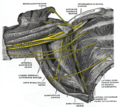| Long thoracic nerve | |
|---|---|
 Nerves of the left upper extremity. (Long thoracic labeled vertically at shoulder, to left of artery.) | |
 The right brachial plexus with its short branches, viewed from in front. (Long thoracic labeled at center, third from top.) | |
| Details | |
| From | Brachial plexus (C5-C7) |
| Innervates | Serratus anterior muscle |
| Identifiers | |
| Latin | nervus thoracicus longus |
| TA98 | A14.2.03.012 |
| TA2 | 6410 |
| FMA | 65275 |
| Anatomical terms of neuroanatomy | |
The long thoracic nerve (also: external respiratory nerve of Bell or posterior thoracic nerve) is a branch of the brachial plexus derived from cervical nerves C5-C7 that innervates the serratus anterior muscle.
